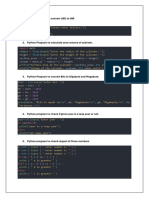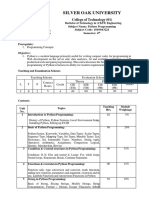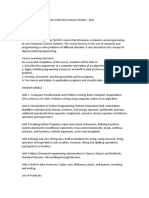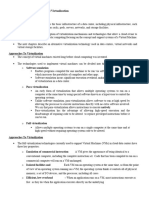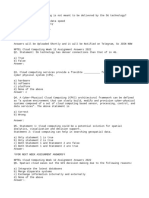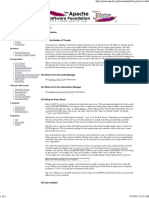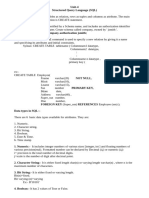0 ratings0% found this document useful (0 votes)
77 viewsProgramming in Python
This document contains a list of 21 programming tasks in Python including: 1) Implementing a stack and queue using lists, 2) Writing functions to check primality, swap list elements, compute factorials and Fibonacci numbers recursively, and find the sum of list elements recursively, 3) Reading and processing text files, 4) Generating simple graphs and charts using Pyplot, 5) Plotting functions, creating a GUI calculator using Tkinter, opening a webpage with urllib, and computing loan EMIs with numpy/scipy.
Uploaded by
Dr. Itesh GuptaCopyright
© © All Rights Reserved
We take content rights seriously. If you suspect this is your content, claim it here.
Available Formats
Download as DOCX, PDF, TXT or read online on Scribd
0 ratings0% found this document useful (0 votes)
77 viewsProgramming in Python
This document contains a list of 21 programming tasks in Python including: 1) Implementing a stack and queue using lists, 2) Writing functions to check primality, swap list elements, compute factorials and Fibonacci numbers recursively, and find the sum of list elements recursively, 3) Reading and processing text files, 4) Generating simple graphs and charts using Pyplot, 5) Plotting functions, creating a GUI calculator using Tkinter, opening a webpage with urllib, and computing loan EMIs with numpy/scipy.
Uploaded by
Dr. Itesh GuptaCopyright
© © All Rights Reserved
We take content rights seriously. If you suspect this is your content, claim it here.
Available Formats
Download as DOCX, PDF, TXT or read online on Scribd
You are on page 1/ 2
Programming in Python [ Python 3.
6 min )
1. Write a Python program to implement a stack using a list data-
structure.
2. Write a python Program to implement Queue using a list data
structure
3. Write a function in Python to check the primarily of an integer
number. Also implement this function in a Python Program.
4. Write a function in Python to swap() first half of the elements
with the second half of the elements. Also implement this
function in a Python Program
Example:
List = [1,2,3,4,5,6,7,8,9,10]
Result = [ 6,7,8,9,10,1,2,3,4,5]
5. Write a recursive function in Python to find the factorial of a
natural number. Also implement this function in a Python
Program.
6. Write a recursive function in python to find out the sum of
digits of any integer number. Also implement this function in a
Python program.
7. Write a recursive function to compute the nth Fibonacci
number. Also implement this function in a Python Program.
8. Write a recursive function in Python to find the sum of all
elements of a list. Also implement this function in a Python
Program
9. Write a recursive Python program to test if a string is a
palindrome or not.
10. Write a Python Program to read a text file. Find out the
total number of words available in this file.
11. Write a program in Python to read a text file line by line
and print it on the screen.
12. Write a program in python to read a text file and remove
all the lines that contain the character `a’ in a file and write it
to another file.
13. Write a Python function sin(x, n) to calculate the value of
sin(x) using its Taylor series expansion up to n terms.
Compare the values of sin(x) for different values of n with the
correct value.
14. Write a random number generator that generates random
numbers between 1 and 6 (simulates a dice).
15. Write a python program to generate a simple bar graph
using Pyplot. The graph should be properly labeled.
16. Write a python program to generate Pie-chart using
Pyplot. The graph should be properly labeled.
17. Write a Python program to plot the function y = x2 using
the pyplot or matplotlib libraries.
18. Create a graphical application that accepts user inputs,
performs some operation on them, and then writes the output
on the screen. For example, write a small calculator. Use the
tkinter library.
19. Open a webpage using the urllib library.
20. Compute EMIs for a loan using the numpy or scipy
libraries.
21. Take a sample of 10 phishing e-mails and find the most
common words.
You might also like
- Sr. No List of Practicals 1. 2. 3. 4. 5. 6No ratings yetSr. No List of Practicals 1. 2. 3. 4. 5. 64 pages
- Grade XII, 2024 - 25, Lab Record ProgramsNo ratings yetGrade XII, 2024 - 25, Lab Record Programs1 page
- List of Important Programs-Python ProgrammingNo ratings yetList of Important Programs-Python Programming3 pages
- Hoilday Assignment (XII) - 26042024 - 112847No ratings yetHoilday Assignment (XII) - 26042024 - 1128472 pages
- Enter Your Name Nishigandha Enter Your Age 22 Nishigandha You Will Turn 100 Years Old in 2098100% (1)Enter Your Name Nishigandha Enter Your Age 22 Nishigandha You Will Turn 100 Years Old in 209814 pages
- CSE3011_Python Programming_List of ExperimentsNo ratings yetCSE3011_Python Programming_List of Experiments3 pages
- EXERCICES ON Python PROGRAMMING LANGUAGENo ratings yetEXERCICES ON Python PROGRAMMING LANGUAGE2 pages
- 2ET1000110P_Python-Programming_PracticalNo ratings yet2ET1000110P_Python-Programming_Practical3 pages
- Write a Python program to swap the values of two variables using a temp variableNo ratings yetWrite a Python program to swap the values of two variables using a temp variable1 page
- G-9 AI Practical Assessment (Python) 2023-24No ratings yetG-9 AI Practical Assessment (Python) 2023-2412 pages
- A Study On The Use of IDE Features For DebuggingNo ratings yetA Study On The Use of IDE Features For Debugging4 pages
- Name: Shubhangi Mapare Roll No: 17112 Div: TE A Subject: SPOS LabNo ratings yetName: Shubhangi Mapare Roll No: 17112 Div: TE A Subject: SPOS Lab7 pages
- Apache JMeter - User's Manual - Best Practices-17 PDFNo ratings yetApache JMeter - User's Manual - Best Practices-17 PDF4 pages
- RITM0096935 - CEE - ZF110 SP GL Indicator Substitution - CombinedNo ratings yetRITM0096935 - CEE - ZF110 SP GL Indicator Substitution - Combined6 pages
- Design and Assimilation of User E-Mail PlatformNo ratings yetDesign and Assimilation of User E-Mail Platform55 pages
- Pass4Test: IT Certification Guaranteed, The Easy Way!No ratings yetPass4Test: IT Certification Guaranteed, The Easy Way!5 pages
- WPShout Ebook Mastering WordPress ThemesNo ratings yetWPShout Ebook Mastering WordPress Themes40 pages
- Standards and Best Practices On Process Server and WIDNo ratings yetStandards and Best Practices On Process Server and WID36 pages
- White Paper On Hybrid Approach For ADAS Data Fusion Algorithm DevelopmentNo ratings yetWhite Paper On Hybrid Approach For ADAS Data Fusion Algorithm Development15 pages
- Scripting (Torque Script) : Concepts and TerminologyNo ratings yetScripting (Torque Script) : Concepts and Terminology41 pages
- develop Applications Mysql: Following UsingNo ratings yetdevelop Applications Mysql: Following Using2 pages





















